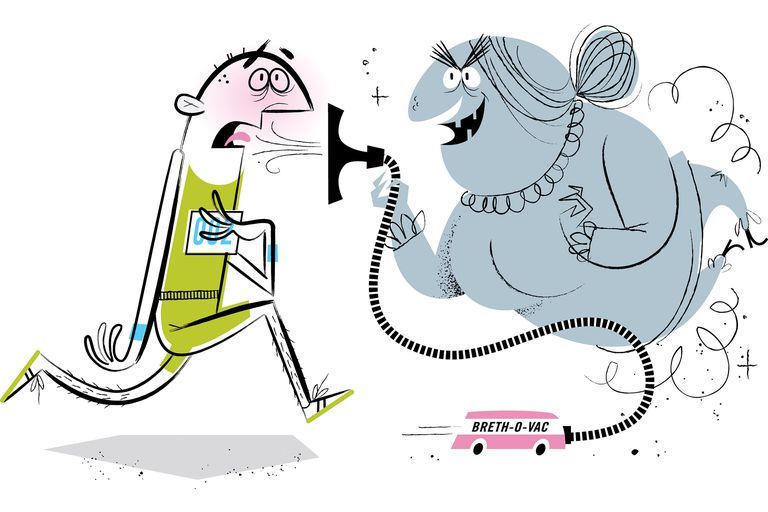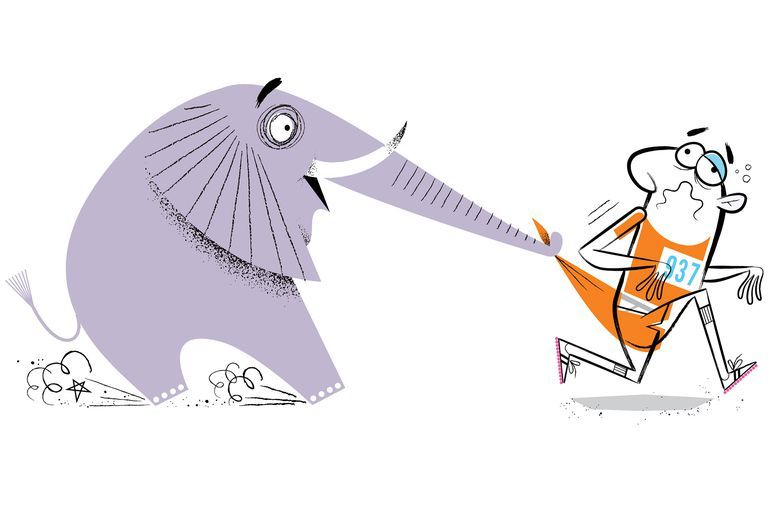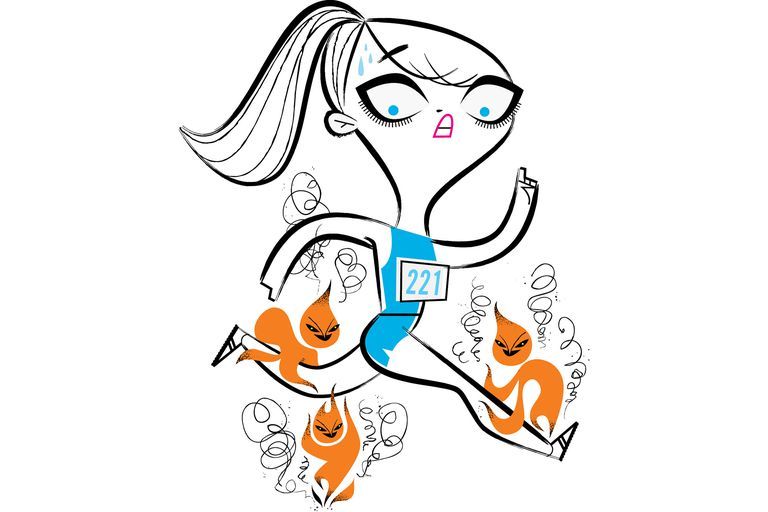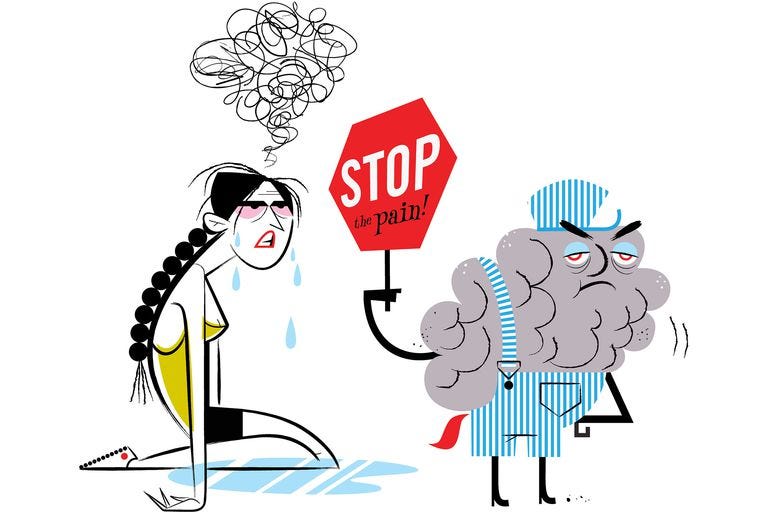There’s something about stopping your watch after crossing the finish line and seeing that you covered the distance faster than ever before. Or nailing your 400-meter interval repeats at a faster prescribed pace. Or even logging into Strava to see the time it takes for you to run your casual neighborhood loop trending up. That feeling of knowing you are running faster can boost your mood for the rest of the day—or month.
But while those moments of improvement can feel amazing, they can also be fleeting. There are times when—whether it be in the first or the final mile—our controlled breathing becomes gasps, our lungs burn, and our legs feel as heavy as the cement we’re pounding.
So what is the secret for how to run faster when you’re in these moments?
It’s important to consider what’s happening to the various parts of the body when you’re on the run. Here are five common roadblocks that every runner may experience—and how to best overcome them.
“I can’t catch my breath!”
What causes this: Oxygen deficit to your muscles
When can it happen: Shortly after starting to run
How to fix it: A “priming” warmup, including a sustained burst of intense running
The first rep of an interval workout often feels like it’s one of the hardest. You’re gasping for air; your heart is pounding. The next rep, though, can feel easier. Why?
When you start running, your muscles’ oxygen needs immediately spike, but the time it takes for the rest of your body to respond to that need is dictated by your oxygen kinetics. So any out-of-breath feeling that you’re experiencing at the start of any run is a temporary mismatch between the oxygen your legs require when running and the oxygen your heart and lungs are able to deliver.
Join Runner's World+ for unlimited access to the best training tips for runners
This oxygen deficit then triggers signals that cause your breathing and heart rate to speed up, dilate the blood vessels, and turn on the oxygen-processing enzymes in the muscles themselves. Usually within two to three minutes, your muscles are getting enough oxygen.
“Your breathing rate doesn’t actually fall; you just kind of settle into it,” says Andrew Jones, Ph.D., a Professor of Applied Physiology in the Department of Sport and Health Sciences at the University of Exeter in England.
The temporary oxygen shortage has lasting implications, though. To meet the energy shortfall, your muscles tap into their precious supply of anaerobic (oxygen-free) fuel stores. That produces metabolic byproducts that make your muscles feel fatigued—and it also leaves you with less energy for the final anaerobic sprint at the end of the race.
“What you burn up in the first couple of minutes is never going to replenish unless you slow right down,” Jones says.
So how do you avoid that temporary oxygen shortage to your muscles? Jones has studied the concept of “priming,” which can get that first-rep fatigue out of the way before you start. We recommend including a sustained burst of intense running in your warmup—like running 45 to 60 seconds at 5K race pace, for example—about 10-20 minutes prior to the beginning of a workout or race. This priming run will activate enzymes and dilate blood vessels, allowing you to more quickly adjust to your race pace.
“I’m running harder, but I’m not speeding up!”
Cause: Inefficient muscle-fiber recruitment
Occurrence: Sustained medium-effort races like a 10K or half marathon
Antidote: Train your fast-twitch fibers to be more efficient.
The early miles of a half marathon often feel pretty easy. You’re not sprinting fast enough to accumulate high levels of lactate and other metabolites; and unlike in a marathon, you’re not running far enough to empty fuel stores. So why does it eventually—and inevitably—get hard?
The answer, according to studies from the University of Copenhagen, once again depends on oxygen kinetics. Over the course of a sustained run at half marathon pace or faster, the amount of energy (and thus oxygen) needed to maintain that pace gradually inches upward. Over the course of 10 or 20 minutes, your oxygen consumption can drift upward by as much as 25 percent, making it progressively harder to hold your pace.
This drift is the result of a shift to less-efficient muscle fibers. When you start running, you automatically recruit mostly slow-twitch muscle fibers, which are suited for long-distance running because they’re efficient and take a long time to fatigue. As time goes on, though, individual fibers begin to fatigue and run low on fuel. To replace them, your brain recruits fast-twitch fibers, which demand more energy—and oxygen—to deliver the same output.
One way to tackle this problem is to train your fast-twitch fibers—usually deployed for explosive movements—to be more efficient. “This might be one reason long runs are so important for marathoners,” Jones explains. A 2.5-hour run, even at a slow pace, will eventually deplete slow-twitch fibers and force your fast-twitch ones to deliver slow-and-steady power. In response, they’ll build endurance by ramping up mitochondrial content and adding capillaries to supply more blood.
“My legs are on fire!”
Cause: Metabolite accumulation in your muscles triggers signals to your brain.
Occurrence: Mile or 5K races, fast surges, or finishing sprints
Antidote: Short, fast interval workouts
Imagine the searing muscular discomfort of a hard interval workout—focused entirely in your thumb. That’s the odd sensation that 10 lucky volunteers in a University of Utah lab experienced in 2014, when a research team led by professors Alan Light and Markus Amann injected a cocktail of metabolites—the chemical byproducts that build up in your muscles during intense effort—into their thumbs. The results were profound: They created sensations of fatigue in subjects not moving a muscle.
For decades, scientists and athletes have talked about “lactic acid burn” triggered by intense exercise. When you run hard, you eventually reach a point where your aerobic energy system—the ultra-efficient fuel supply that relies on oxygen delivered by your heart and lungs—can’t supply energy to your muscles quickly enough. You turn instead to anaerobic (oxygen-free) energy sources, which provide much-needed fuel but also generate metabolites that build up in your muscles. One of those metabolites is, indeed, lactate (a molecule that’s closely related to lactic acid). But despite its nasty reputation, lactate, on its own, doesn’t make you tired.
Light and Amann tried injecting their volunteers with three different metabolites: lactate; protons, which make your muscle more acidic; and adenosine triphosphate, a form of cellular fuel. When the chemicals were injected alone or in pairs, nothing happened. But when they injected all three together—bingo! At first the subjects reported feelings like “fatigue” and “heavy” in their thumbs, even though they were sitting. Then, when researchers injected higher metabolite levels that would correspond to all-out exercise, the sensations shifted to “ache” and “hot”—the so-called lactic burn, created in a test tube.
You definitely want to become a faster runner. Sign up for Runner’s World+
The results show that, regardless of what it feels like, your muscles aren’t being dissolved by lactic acid. It’s only when special receptors in your leg muscles detect a particular combination of metabolites that they trigger a distress signal that travels up your spinal cord, which your brain interprets as a burning sensation. One solution? Train the receptors to be a little less sensitive by repeatedly triggering them in training. “The first time you do intervals after the offseason, you think you’re dying,” notes Amann. But after just one or two workouts, “it already feels a bit better.”
“I can hardly lift my legs!”
What causes this: Metabolite accumulation hinders contraction in the muscles.
When can it happen: Near the end of hard races
How to fix it: Prudent pacing
Now we know that the “lactic burn” is really just a sensation in the brain, triggered by nerve sensors in the muscle. Does that mean that the muscles themselves can keep going indefinitely if you somehow ignore those signals? To find out, Amann and his colleagues injected a nerve block called fentanyl into the spines of volunteers, preventing signals from traveling up from the leg muscles to the brain, and asked them to ride 5K as hard as they could on a stationary bike.
The results were dramatic. When the first subject finished and tried to step off the bike, he nearly collapsed on the floor before Amann and his researchers caught him. All subsequent subjects had to be helped off the bike. Some couldn’t unclip their feet from the pedals, Amann recalls, “and not a single one was able to walk.” They had all been given a gift that many athletes dream of—the ability to push as hard as they wanted without feeling much pain or fatigue—and now they were paying the price, with muscles that had essentially ceased to function.
Yet despite their temporary superhuman status, the subjects didn’t ride faster than when they received a placebo injection. “They always feel great initially,” says Gregory Blain, Ph.D., one of Amann’s colleagues. “They’re flying. But”—he flashes a wicked grin—”we know they’re going to crash.” By the halfway mark, the cyclists still felt great, but they started to look puzzled, because their legs were no longer responding to the commands sent by their brains. Whatever advantage they gained from their fast start soon dissipated as their legs stopped responding.
In this case, the fatigue really is in the muscles rather than the brain. Without any warning signals in the brain, metabolites such as protons and phosphate ions accumulate far beyond levels that directly interfere with the ability of the muscle fibers to contract. In other words, the fatigue produced by metabolites isn’t “all in your head”—instead, you experience a mix of “central” (in the brain) and “peripheral” (in the muscles) fatigue during hard runs. Push too hard at the start of a race, and you’ll discover just how real those peripheral limits are.
“I give up!”
What causes this: Effort overload
When can it happen: Anytime you’re pushing your limits
How to fix it: Train your brain.
It hurts too much—that’s the simplest way to explain why you don’t push a little harder during those crucial final miles.
But it’s not quite right. Pain—the feeling that makes you go “ouch!”—isn’t what holds you back. When researchers at Great Britain’s University of Kent ran electric current through the brains of volunteers to dull their sense of pain, using a technique called transcranial direct current stimulation (tDCS), it didn’t improve how subjects felt during exercise or how they performed in a ride to exhaustion on a stationary bike.
What matters, according to exercise physiologist Samuele Marcora, Ph.D., one of the authors of the Kent study, is effort: the struggle to continue against a mounting desire to stop. All the other forms of fatigue—oxygen deficits, metabolite accumulation, overheating, dehydration, muscle damage, fuel depletion, and so on—contribute to your overall sense of how hard it would be to maintain your pace or speed. Effort, in other words, combines all the different fatigue signals that emanate from every corner of your body—and the moment of truth in any race corresponds to maximum effort.
Runners spend most of their training time trying to make their muscles, heart, and lungs stronger and more efficient. But Marcora’s theory suggests that altering your subjective sense of effort is another way to run faster. Studies have successfully altered effort—and endurance—using techniques such as subliminal messages (smiling faces flashed for a fraction of a second), electric brain stimulation (with electrodes positioned to alter perceived effort instead of pain), motivational self-talk (Feeling good!), and “brain endurance training” (computerized tasks completed while exercising on a stationary bike).
The big question, though, remains unanswered: What is effort, exactly? Is it a psychological state? Is it the tactile sensation of your muscles contracting? Or is it, as Marcora believes, our overall sense of how hard it is to maintain race pace? We’ve learned a lot about what happens in the body when we run, and come up with explanations for many of the sensations we feel and limits we encounter. The next great training leaps will come from understanding the brain.
Now that you have a better understanding of what makes your body feel tired when you’re running certain speeds and certain distances, you might be wondering, what are some run-specific ways for you to increase your speed? Here are some training tips on how to get faster.
Increase your mileage each week
Take a quick look at the structure of a few training plans (even if you’re not training for a race just yet). They’re designed to gradually increase your distance and push your speed without overdoing it. Try a few short weekday runs, then one weekend long run that gets progressively longer each week.
Listen to your body
Common running wisdom says not to increase your total mileage by more than 10 percent a week—but if you’re feeling good, experts say there’s no reason to limit yourself. That doesn’t mean you should double your mileage over the course of seven days (that’s a one-way ticket to shin splints); it just means you should pay attention to how you’re feeling and adjust your mileage accordingly.
Add speed to your long runs
Exhausting your body with speed helps the body experience the fatigue it may face on race day. Focus on picking up your pace for a short amount of time in the second half of a long run, or do some strides after you’re done to get a little turnover (and faster).
Do separate speed workouts—but don’t stress over them
Within your regular training, do a speed workout, like four half-mile repeats with two minutes of easy jogging in between, that you can build on week after week.

















